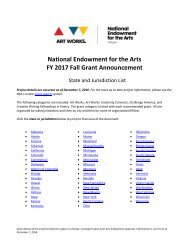BERKELEY
program-ic
program-ic
You also want an ePaper? Increase the reach of your titles
YUMPU automatically turns print PDFs into web optimized ePapers that Google loves.
week; travel guides were written for each state; murals were<br />
commissioned for public buildings; and plays were performed<br />
in multiple languages. These projects shaped the American<br />
physical and cultural landscape as we know it.<br />
Of course, no bold enterprise can exist without disapproval.<br />
By 1935, critics of the New Deal had cropped up across the<br />
country, many of them identifying as Republicans. Historically,<br />
Republicans favored bigger government and Democrats preferred<br />
a less hands-on federal presence. But many Republicans<br />
began to feel that the New Deal overstepped appropriate<br />
bounds and impinged on the private sector, posing a threat<br />
to big business. The parties flipped in response and became<br />
what we recognize today: Democrats advocated for expanded<br />
government, and Republicans wanted to limit federal reach.<br />
Another critic of the New Deal was the populist Louisiana<br />
governor Huey Long, known as “the Kingfish,” who led with a<br />
tight fist and a smile. Long became immensely popular when<br />
he expanded social services and developed badly needed<br />
infrastructure. He was notorious for overcoming opposition<br />
through intimidation and bribery, yet remained widely beloved.<br />
When he was elected to the Senate he began Share Our<br />
Wealth, a national movement that aimed to radically redistribute<br />
wealth: taxes would cap large fortunes and everyone<br />
would receive a guaranteed income equal to at least one third<br />
of the average family income. In an interview with The Nation<br />
Long was asked how he could carry out Share Our Wealth<br />
without instituting socialism. He said, “What sense is there<br />
running on a Socialist ticket in America today? What’s the use<br />
of being right only to be defeated? First you must come to<br />
power—power—then you do things.” Long proved himself<br />
an extremely controversial figure: many fervently attached<br />
themselves to Long’s message of “Every man a king,” and<br />
others, including Sinclair Lewis, denounced him as a dangerous<br />
demagogue. In 1935, Long announced his plan to run for President<br />
against Roosevelt, running for his second term.<br />
The climate of this election year was a frequent topic of<br />
conversation between Lewis and his<br />
wife, Dorothy Thompson, an<br />
international political<br />
reporter and anti-fascist<br />
writer. In a letter<br />
she wrote Lewis while<br />
out of town on assignment,<br />
she noted that the<br />
Roosevelt Administration<br />
is “on the rocks” and that<br />
fdr “will probably be<br />
reelected in 1936,” but “if<br />
things move in the present<br />
tempo I think we may very<br />
easily have a Republican-fascist<br />
dictatorship in 1940.”<br />
Thompson also fed Lewis<br />
information about the shifting<br />
ground in Germany: she was<br />
the Berlin bureau chief of the<br />
Central European News Service<br />
until Hitler eventually expelled<br />
her from the country.<br />
These conversations prompted Lewis to imagine what fascism<br />
would look like on the home front. Particularly influential<br />
was an interview Thompson conducted with Huey Long, in<br />
which Long indicated that he thought he could beat fdr on a<br />
third-party ticket. The couple believed Long was flirting with<br />
fascism. Lewis began writing It Can’t Happen Here when he created<br />
a fictional happy-go-lucky, paranoid president-turned-dictator<br />
named Buzz Windrip—modeled after Long—who beats<br />
Roosevelt in the 1936 election. Lewis solidified the Long-Windrip<br />
parallel by creating the character of Bishop Prang, who<br />
resembled Long’s ally, the demagogic, bigoted radio personality<br />
Father Charles Coughlin, whose fiery speeches attracted<br />
an audience of around 30 million listeners.<br />
Lewis wrote It Can’t Happen Here in two months. It was<br />
almost too timely: Long was assassinated before election<br />
candidates were even announced, and Lewis had to do rushed<br />
rewrites to refer to Long in the past tense. The novel came out<br />
on October 21, 1935; it made the bestseller list and was praised<br />
by reviewers of all political stripes. The New Yorker called it<br />
“one of the most important books ever produced in this country”<br />
and The Nation called it “a weapon of the intellect.”<br />
CONTINUED ON NEXT PAGE<br />
Left to right Father Charles Coughlin, Benito Mussolini, Adolf Hitler, Huey Long<br />
2016–17 · ISSUE 1 · THE <strong>BERKELEY</strong> REP MAGAZINE · 21




